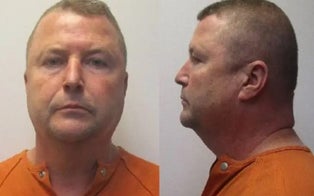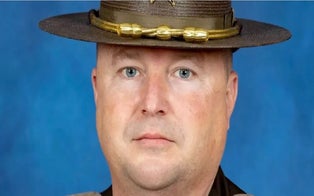Winston Moseley, a psychopathic serial killer and necrophiliac, was 81 years old when he died at the maximum security Clinton Correctional Facility.
The man convicted of the 1964 rape and murder of Kitty Genovese, who was repeatedly stabbed on a New York street while neighbors largely ignored her cries for help, has died after almost 52 years in prison, officials said.
Winston Moseley, a psychopathic serial killer and necrophiliac, was 81 years old when he died at the maximum security Clinton Correctional Facility in Dannemora, New York, on March 28, according to the New York State Department of Corrections and Community Supervision.
A medical examiner will determine cause of death.
He had been imprisoned since July 7, 1964 and was one of the state’s longest-serving inmates.
Moseley was 29 years old when he stalked and attacked Genovese as she walked to her Kew Gardens, Queens apartment from her car about 3:15 a.m. March 13, 1964.
Genovese, 28, had come home from working the late shift at a Queens bar and parked in the nearby Long Island Rail Road parking lot. She had only 100 feet to walk until she reached her door, located in an alleyway near the rear of the building, when Moseley approached her.
He ran after the frightened woman and stabbed her twice in the back before she could reach the major thoroughfare of Lefferts Boulevard, just up the block.
“Oh my God, he stabbed me! Help me!” several neighbors said they heard Genovese scream, but few said they realized that the cry was one for help.
Moseley, 29, ran away when one neighbor shouted “Let that girl alone!” but witnesses said that after driving away, he returned ten minutes later.
“I had a feeling this man would close his window and go back to sleep, and sure enough he did,” Moseley later said in court.
Read: New Book Marks 50th Anniversary Of Kitty Genovese's Murder
He searched the parking lot, train station and an apartment complex, eventually finding a barely conscious Genovese in a hallway at the back of the building, where she had collapsed when she was unable to get through a locked door. She was completely out of view of any witnesses.
Moseley stabbed her several more times, raping her as she lay dying and taking $49 from her before fleeing.
Defensive wounds on Genovese’s hands suggested that she tried to prevent the attacks, which lasted about half an hour. She had been stabbed at least 14 times.
Police arrived after a witness called police minutes after the final attack, but it was too late. Genovese died on the way to the hospital about 4:15 a.m.
Moseley was arrested six days after killing Genovese during a house burglary. At the time of his arrest, he had been working a steady job, had no prior criminal record and was married with two children.
The brutal killing was completely random. Moseley later said he had simply wanted “to kill a woman.”
He told police he left his sleeping wife at home and drove around to find a victim, finally spotting Genovese and followed her to the parking lot.
He later confessed to murdering and sexually assaulting two others, 24-year-old Annie Mae Johnson and 15-year-old Barbara Kralik, saying that he preferred to kill women because “they were easier and didn’t fight back.” He also confessed to between 30 and 40 burglaries.
Despite pleading not guilty by reason of insanity, Moseley was found guilty and sentenced to death.
“I don’t believe in capital punishment, but when I see a monster like this, I wouldn’t hesitate to pull the switch myself,” Judge J. Irwin Shapiro said at the time.
His initial death sentence was reduced to lifetime imprisonment, to which two additional 15-year sentences were tacked on for crimes—including another rape—he committed when he escaped from custody on March 18, 1968.
Moseley made a getaway when he was being taken back to prison from a Buffalo hospital, hitting a corrections officer and taking the man’s weapon before fleeing to a nearby vacant house.
When the couple who owned the home checked on the house three days later, Moseley bound and gagged the husband and raped his wife.
Moseley stole the couple’s car and fled to another house, where he took a woman and her daughter hostage. He left them unharmed after holding them captive for two hours. Moseley surrendered to police shortly thereafter.
He had been denied parole 18 times before his death, reportedly having shown little to no remorse for killing Genovese and at one point saying he considered her murder to be a mugging and never intended to kill her.
The Implications of the Genovese Murder
Genovese’s murder came to symbolize a perceived callousness or apathy of life in an urban environment, New York in particular, as accounts of the killing said 38 people heard the dying woman’s pleas but did nothing to help.
In one reported account, a witness was said to have told police he stood at the top of the staircase and watched as the young woman was fatally stabbed but said. “I didn’t want to get involved.”
“The phrase that came out of this was, ‘I didn’t want to get involved,’” Kevin Cook, author of ‘Kitty Genovese: The Murder, the Bystanders, the Crime that Changed America, told INSIDE EDITION as the 50th anniversary of the woman’s murder approached.
The exact number of witnesses was never definitively determined, but officials believe it may have been far less and actually about 12 people, two of which who eventually called police.
“There were certainly dozens of ear-witnesses and eyewitnesses, but when you talk about the people who heard something or saw something and knew what it meant, I don't think it's more than half a dozen," Cook said.
But researchers who studied the case said the fact remained that that being part of a crowd seems to alter a person’s sense of personal responsibility.
In the social phenomena, known as the bystander effect or Kitty Genovese syndrome, individuals witnessing an emergency are less likely to step in if others are present.
“Thirty people must have called the police by now,” a local woman is said to have told her husband.
A 1969 study found that 70 percent of people would call out to or help a woman in distress if they were alone, but only 40 percent did something when other people were there.
Moseley seemed to know this, telling detectives that he “knew they (witnesses) wouldn’t do anything, people never do.”
Genovese's girlfriend at the time, Mary Ann Zielonko, reflected on the crime in a 2004 interview with Sound Portraits Productions, saying: "I still have a lot of anger toward people because they could have saved her life, I mean, all the steps along the way when he attacked her three times.
“And then he sexually assaulted her, too, when she was dying. I mean, you look out the window and you see this happening and you don't help. That's — how do you live with yourself knowing you didn't do anything?"
Read: Book Published by 'Worst Serial Killer in History' Pulled from Shelves Amid Public Outcry
One neighbor did do something. When she heard what was occurring, Sophia Farrar courageously stepped out of the safety to her apartment to help Genovese as she lay dying.
“Help is coming,” Farrar reportedly promised Genovese as she held her in her arms until an ambulance arrived. The woman had no way of knowing if Moseley was still in the area or would come back.
Genovese’s murder was also pivotal in the creation of the nation’s emergency response system.
At the time of her killing, there was no 911 emergency number and instead, residents were left to call local precincts to report a crime.
A neighborhood man told Cook his father called the police about the brutal attack.
“He swears his father did call the police, was put on hold, told the police - there's a woman staggering around out there! You need to come! There was no answer to that call,” Cook said. “In those days, there was no 911 system. That's something that came out of the Kitty Genovese case, at least indirectly.”
Her murder also inspired the creation of neighborhood watch program and other reforms including crime-victim compensation, sex offender registries and laws that allow victims’ families to speak during the penalty phase in felony trials, according to Cook.
Remembering the Woman Whose Murder Changed the Nation
Born in New York City to Rachel and Vincent Genovese, Catherine, commonly known as Kitty, was the eldest of five children.
She was raised in Park Slope, Brooklyn and at 19, chose to remain in the city when her family moved to Connecticut in 1954 after her mother witnessed a murder.
Genovese often spent her time in Manhattan’s Greenwich Village, where she met her girlfriend Kielonko. The pair fell in love in 1963, after slow-dancing in a crowed bar, and shared the apartment Genovese was on her way home to, Cook wrote.
Genovese had dreamed of opening her own Italian restaurant and worked diligently as a bartender and manager at Ev’s 11th Hour in Hollis, where regulars described her to Cook as cheerful and optimistic.
Genovese is burned in a family grave at Lakeview Cemetery in New Canaan, Connecticut.
Her brutal murder has stayed with her family, who wished for her killer to remain behind bars until he died.
“He can spend another 40 years in jail,” her brother Vincent Genovese told the New York Daily News in 2008 when Moseley was up for parole. “He can rot in jail.”
Watch: Real Estate Agent Killer Gets Life, Son Says: He Threw Her Away Like Trash





